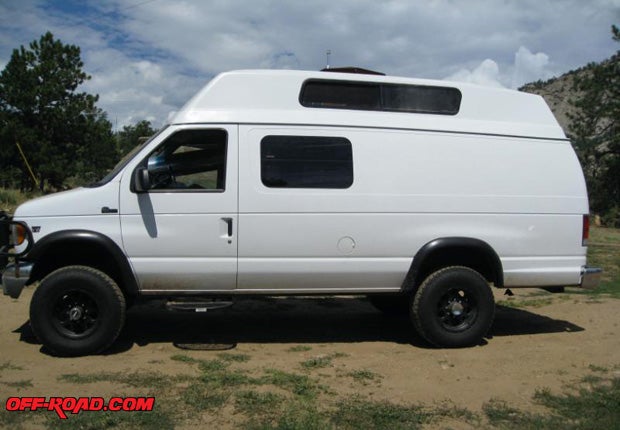
Last month’s article, Part 2 of the Project Motovan build, left off with the decision to select Colorado Campervan (http://coloradocampervan.com/) to build the interior conversion on Project Motovan. While talking with a few van owners prior to purchasing the van, I came across one gentleman named Jamie that was in the process of building his own 4x4 Quigley van. He had been doing his own research on different layout options, different materials and appliances to use in his build to make it the most functional for his family. In addition he was an avid dirt biker like me, so we also ended up talking a lot about dirt bikes. Without knowing it I had actually begun a conversation with one of the future owners of Colorado Camper van prior to Colorado Campervan even starting as a company.
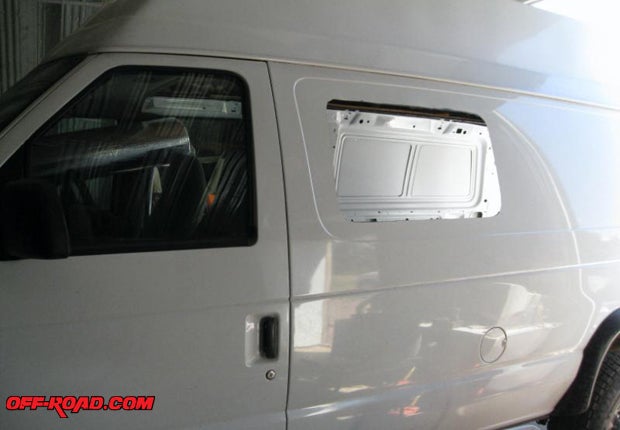
Fast forward a few months after the purchase of Project Motovan and I was still in contact Jamie exchanging information on ideas I had come up with and listening to any new ideas he had in mind. He started mentioning another van nut he had met named Derek that was also a dirt bike rider, mechanic, fabricator of sorts and an avid 4-wheeler. Derek had a 4x4 Quigley passenger van he was also building for camping and hauling his toys. He had already designed and built his own pop-top out of a used fiberglass top he had picked up. Derek’s design used an electric motor to raise the top into position and also incorporated an optional fold out rear section that adds additional sleeping and storage room. Impressive!
As time moved on, Jamie and Derek became friends and realized they both had a passion for building 4x4 vans. With both of them owning 4x4 vans and with each of them having their own specialized skill sets it seemed like a great fit, so they went into business together and started Colorado Campervan. I found out about them being officially in business right before getting the hard top installed on Project Motovan. At that point I hadn’t really even thought of using Colorado Campervan for Project Motovan – after all, their business is located in Colorado and Project Motovan is in California.
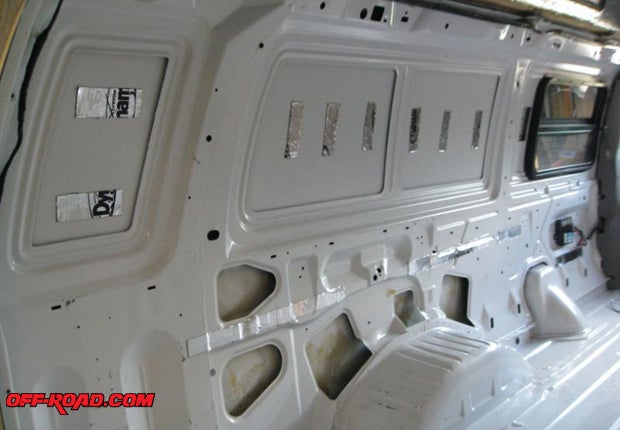
Once I figured out that Sportsmobile was booked and not an option for our schedule, I started researching other van-conversion options located in California. At the same time I started talking to Derek at Colorado Campervan and asked him some mechanical questions and general build advice on Project Motovan. I immediately felt confident in Derek’s knowledge of mechanical things and ran off some ideas against him to get his feedback. After a few phone conversations, I knew Derek was the guy to build the van, despite being across the country. The few companies I found online seemed to do good interior work but wouldn’t do things like fabricate a battery rack, install a heater or take on other more mechanical-related things. Derek isn’t afraid to tackle those types of tasks and has the past experience with building 4x4 rigs and fabricating suspension systems and other things to get the job done. In addition, he is just a great, down-to-earth person who is passionate about vans and helping others build their own.
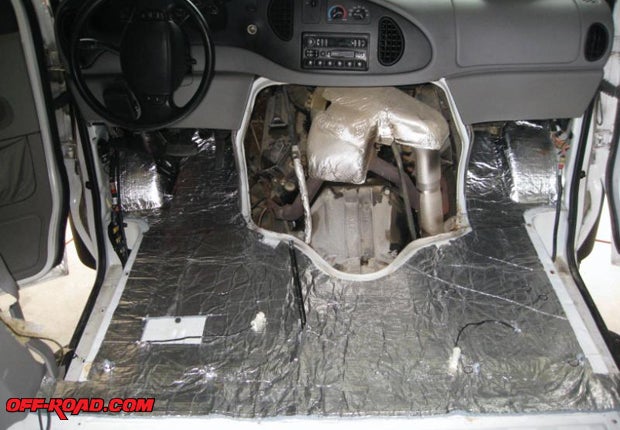
Once I made my decision I scheduled a weekend to drive the van to Colorado and drop it off with Derek. The weekend arrived and I was packed up and in Vegas having lunch with a friend before I knew it. While en route to Grand Junction, Colorado, to stay the night I checked in with Jamie and he invited me to spend the night at his place in Salt Lake City, Utah, instead of a Hotel in Grand Junction. Looking at the map it wasn’t a big diversion and since we had never met in person I thought what better opportunity that to take him up on the offer. Jamie and I checked out each other’s vans and then proceeded to talk vans into the wee hours of the morning before I caught a couple hours of sleep and hit the road again.
I rolled into Derek’s shop in Colorado just before dark that next day. Being the chef he is, Derek whipped up a Digorno pizza in the oven and we chowed down while wasting no time talking about the details of the Project Motovan interior build. Before the night was done, we had decided on a general layout for the van that would prove functional, comfortable and not break the bank. Our initial layout would consist of using a removable stock Ford bench seat directly behind the front captain chairs. This would provide seating for three more people as well as give the ability to install child seats legally and safely. In addition, the bench seat would be removable for the times when it is just me heading out on a riding trip and wanting to use that room for gear.
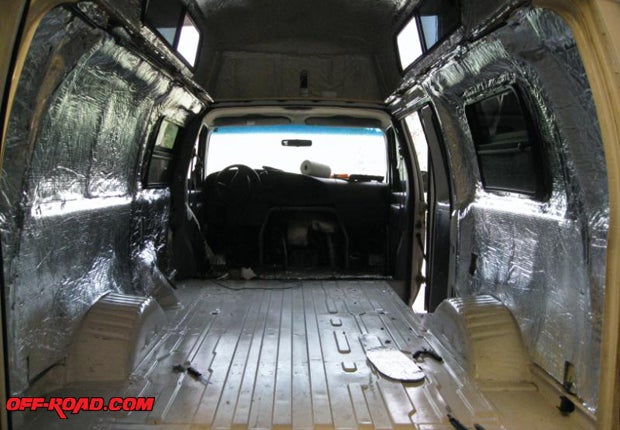
Behind the factory bench seat and along the driver’s wall we opted to build a custom bench type seat that would pull out and make into a bed, commonly referred to as a “Goucho.” This would give a good place to sit or lie down while camped but still keep a walkway through the van. Then when time for bed rolls around, the bench will pull out and make into real bed. Underneath the pull-out bench/bed combo will be the mounting location for the electrical panel and any other electronics we need to wire in. In addition it will hold the fresh water tank of a yet-to-be-determined size. That will pretty much take care of the driver’s side of the van layout.
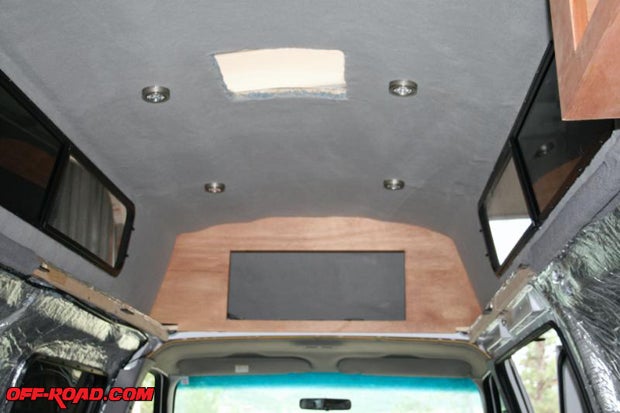
One main layout idea I wanted to stick with is to keep a walkthrough area from the rear doors to the side barn doors. A few reasons for this are to make the van feel more open inside, to allow people to walk through the van and also to be able to still use the van to carry long items when making runs to Home Depot or a furniture store. With that focus in mind, Derek and I decided on building custom cabinets along the passenger side of the van that would come out just a little past the wheel well. These lower side cabinets would hold a sink, a refrigerator, a small microwave and also provide some limited storage and countertop space.
Taking advantage of having the hardtop and the extra room up above, Derek suggested we build some cabinets in the front and rear of the van. The front section of the van above the driver and passenger still has the original roof in place between the hard top and offers a great location for storage space in which a cabinet will be created. In the rear of the van will be several cabinets forming a U shape that can be used to store basic lightweight supplies. The rear cabinets on the driver’s side will come out a little more than those on the passenger side to take into account the walkthrough room needed for the headroom of people walking through.
With the basic layout figured out, Derek and I started to focus on the immediate things that he would start to work on over the next few weeks. One of the first things that needed to be done is to insulate the van and install a couple of windows. Insulating a van this big takes some careful research to make sure the van can maintain livable interior temps when the outside conditions are either hot or cold. Just throwing in some house insulation wasn’t going to cut it. Luckily, Jamie had done some extensive research into insulation options and found a great company called QuietRide Solutions.
I made a call to Timothy Cox of QuietRide Solutions (http://www.quietride.com/) to find out for myself if it was right for Project Motovan. I learned that QueitRide specializes in pre-cut, ready-to-install insulation kits for all types of vehicles ranging from model year 1928 up through current models, including our E-350 van. Their mission statement is “to provide quality products that are easily installed by both the home and professional mechanic, as well as the average do-it- yourselfer, with a minimum amount of effort and toil.” Timothy educated me about how their product not only controls temperature but is also designed to control automotive noise and vibration as well.
The QueitRide insulation is made up of two sheets of 99.5% pure industrial grade aluminum laminated to 3/8" fiber tech padding, resulting in a Insulation "R" factor of 18.3. What makes the QueitRide kits a big bonus over just normal insulation is that they also tackle noise and vibration by using strategically placed strips of Dynamat throughout the van. Dynamat is a popular product within the car audio industry to help quiet down vehicle interiors and dampen vibration, leading to better sounding stereo systems. Our Project Motovan 7.3 Diesel is loud, generates plenty of heat and the motor definitely vibrates more than the typical gas engine. The addition of the insulation and Dynamat that comes in the QuietRide kit will be very welcome.
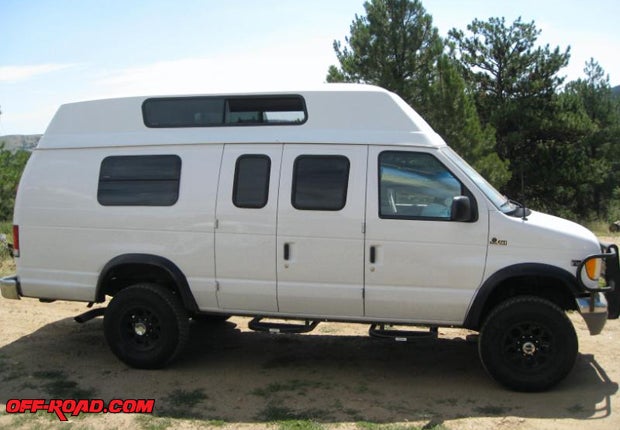
Visibility inside the van when camping is important so I wanted to add a few windows. Adding windows, however, causes the loss of insulation and allows sunlight and cold temps to sneak in. To strike a balance, Derek helped me pick out four windows, two on each side. The first one would be placed on the driver’s side next to the passenger bench seat and the second would be placed on the right rear section of the passenger side. The front-side window will allow passengers sitting in the bench seat to see out both sides, while the passenger-side rear window will allow me to see outside while sitting or laying down on the rear Goucho. In addition the passenger-side rear window will also help with backing up and with blind-spot visibility, which is a big plus in an extended van. The other two windows will go into the sides of the hardtop and allow visibility when standing as well as ventilation.
After deciding upon the QuietRide insulation and the four windows, Derek had his next week or two of work already cut out for him. I caught a plane back to California the next day and Derek ordered the windows. Within a few days, Derek had received both the insulation kit I had ordered and the windows. Starting with the windows, Derek used the provided templates to trace out the window holes and then made the cuts. I was glad I was sitting across the country when Derek started cutting into the van since I had enough of it watching the top get sliced off! He sent me photos of each step so I could follow the progress and was really happy with how the windows turned out. The lower windows open “awning” style so that they can be left open even if it is raining out.
With the windows installed the next step was to install the Dynamat and insulation. Most people, including myself, would think that the more Dynamat the better. Dynamat is heavy and the best choice is to use enough to provide the damping and noise deadening but not too much to add excessive weight. Luckily QuietRide has that balance figured out and Derek just had to follow the instructions on where to install everything. Once the Dynamat was installed, Derek rolled on the provided adhesive and then the insulation throughout the van. Timothy from QueitRide created a custom kit for the Project Motovan hardtop from my measurements and it worked out great. All the insulation is installed in the van now with the exception of the floor insulation, which will be done just before the flooring is installed as to prevent trampling or damaging it.
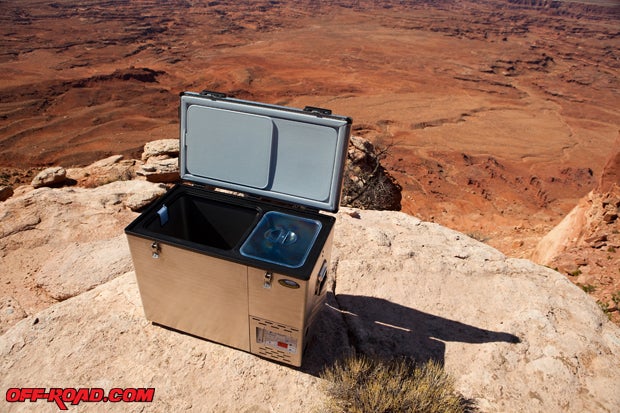 Next up, Derek was ready to start on the cabinets on the passenger side of the van. To do this he really needed to know what type of appliances I was going to use so that he could account for the dimensions. I had Derek just pickup a small microwave for me and I set out to choose a refrigerator for the van. My requirements for a refrigerator were to have enough room to store the basics in the fridge section like drinks, lunch meats and condiments but also have a good-sized freezer compartment. Many folks don’t use a freezer on camping trips but I do. I like to take along ice for drinks, a few microwave quick-fix dinners and sometimes even some ice cream for after a long day of riding in the desert.
Next up, Derek was ready to start on the cabinets on the passenger side of the van. To do this he really needed to know what type of appliances I was going to use so that he could account for the dimensions. I had Derek just pickup a small microwave for me and I set out to choose a refrigerator for the van. My requirements for a refrigerator were to have enough room to store the basics in the fridge section like drinks, lunch meats and condiments but also have a good-sized freezer compartment. Many folks don’t use a freezer on camping trips but I do. I like to take along ice for drinks, a few microwave quick-fix dinners and sometimes even some ice cream for after a long day of riding in the desert.
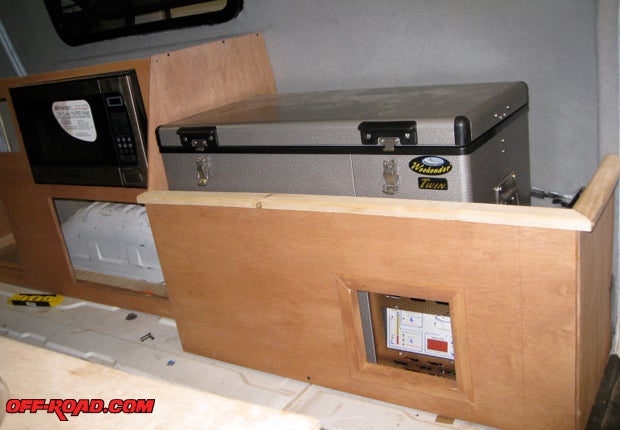
I began by researching the different RV-type units that get mounted into a fixed cabinet space, similar to what I had in my old trailer. Unfortunately all of the options that offered a reasonable freezer section proved to be just too big for our planned location in the van. Having done some off-roading recently in Australia while visiting family, I recalled seeing some of the off-roaders there using portable refrigerator/freezer units in their Toyota Land Cruisers type vehicles. The ability to move the refrigerator from the van to another location sounded like a great idea, especially when attending a race or sporting event where you could bring the refrigerator to your seating location for a few hours. Switching gears I began looking online for information on these types of refrigerators.
From researching online it became apparent there were several main name brands of refrigerators/freezers that had been proven in harsh off-road conditions, such as ARB, Engel, National Luna and Waeco. Each of these units cools down extremely quickly when compared to a standard RV refrigerator due to their compressor design. This quick cooling capability is a big plus for last-minute trips when there isn’t time to plug in a refrigerator the night before to get it cooled and ready. All of the units were also well insulated, had quiet and very efficient compressors and came in various sizes. Above all they were expensive, very expensive! The interesting thing was that most of them didn’t have both a refrigerator and a freezer. There was one main compartment that could be set at either refrigerator or freezer temperatures.
The other thing to point out is most of these brands are built outside of the US and need to be imported by an authorized dealer. When digging a little deeper into the different brands I came across the fact that the National Luna freezer won the Overland Journal Editor’s Choice Award. I started searching for an authorized National Luna dealer in the US and found Equipt Expedition Outfitters (http://www.equipt1.com/), a leading North American importer of vehicle-based expedition equipment. I contacted them and spoke with Paul and told him I was looking for a model that had a both refrigerator and freezer. I was pleasantly surprised to learn that National Luna is now offering a model they call the Weekender that is targeted at the recreational user at a lower price point than their high-end freezers.
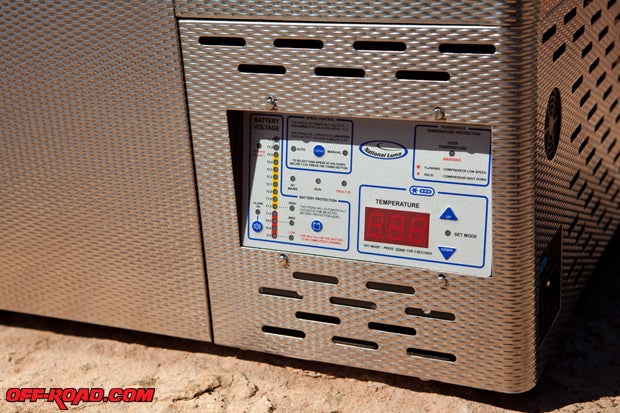
Luckily for us the South African-built National Luna Weekender also comes in a “Split” model offering two separate compartments, one 40-liter refrigerator section and one 10-liter freezer section. Paul schooled me on the fact that the freezer compartment stays at a constant 18-20 degrees cooler than the refrigerator side. On top of the fact that this unit has both compartments, it also has the sought-after efficient Danfoss compressor, a 3 level selectable battery protection system and a digital temperature display. The Weekender comes in either an aluminum model or a stainless-steel model, but for our budget and our needs the aluminum model should be perfect.
While on the phone with Paul he also mentioned National Luna also has a dual battery intelligent charging system. Since I had already planned on adding a solenoid that would allow charging both the van batteries and the house batteries my ears perked up and I listened to what Paul had to say. The system sounded similar to the one I had in mind in that it protects the main van batteries and makes sure they are charged before charging the house batteries. The National Luna setup also provides a monitor showing the condition of both battery banks and allows an emergency override so that the house batteries can also assist in starting the van if needed. As it turns out this was the same system that Derek’s brother-in-law uses on his well-outfitted 4x4 Land Cruiser and he loved it. Convinced it was a great system, I provided Paul with my credit card info and both the Weekender refrigerator and the dual battery charging system were on their way to Colorado Campervan.
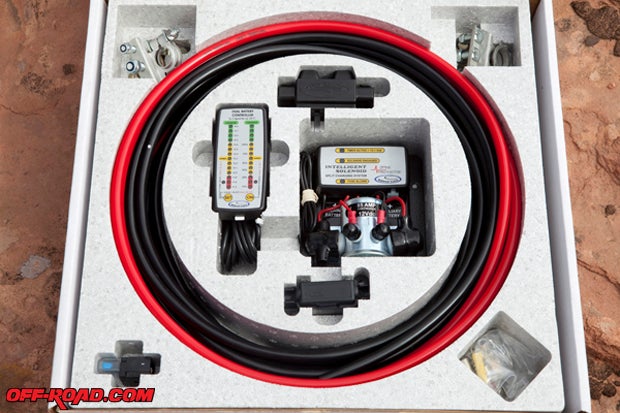
Derek has since received both items and has already started to build the cabinet around the refrigerator. He is locating the refrigerator at the rear of the van so that it can be accessed easily from both inside and outside the van, thus saving the hassle of having the climb inside every time to grab a drink. The cabinet will have a cutout to show the display and also have enough room around it to allow the unit to stay cool. The cabinet will come up to the sides of the refrigerator but not over the top, allowing it to be easily opened and removed. Since it can operate off either 12v or 120v, Derek is installing both options next to the unit.
Project Motovan is definitely moving in the right direction. At this point in the build we are in contact with Derek from Colorado Campervan at least a couple times a week exchanging ideas, photos and general information. He keeps us up to date on his schedule of what his doing next and the approximate amount of time he expects each task to take. It is exciting to witness the progress of the van and also reassuring to hear Derek’s suggestions when he thinks something can be done differently to be more functional. As Derek continues to work on the interior of the van we have been researching some different options for tuning the 7.3-liter Diesel engine. Check back next month for coverage on what we figure out!


 Your Privacy Choices
Your Privacy Choices